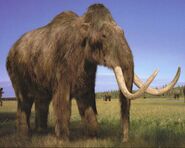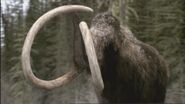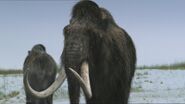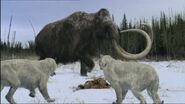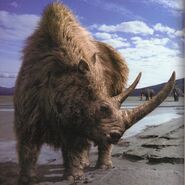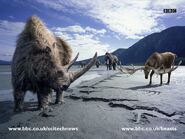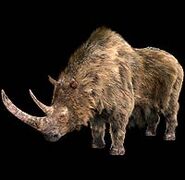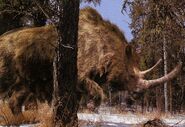No edit summary |
|||
| (36 intermediate revisions by 12 users not shown) | |||
| Line 1: | Line 1: | ||
| + | {{Infobox period|image = Plestocene.png|creatures = ''[[Pleistocene#Featured Animals:|See full list below]]''|locations = [[Europe]], [[North America]]|span = 2 mya-11,700 ya|era = [[Cenozoic]]|previous = [[Pliocene]]|next = [[Holocene]]}} |
||
| − | [[File:WWB1x6_MaleWoollyMammothInWinter.jpg|thumb|400px]]<span style="line-height: 115%; font-family: "Times New Roman","serif"; font-size: 14pt; mso-bidi-font-size: 12.0pt; mso-fareast-font-family: "Times New Roman"; mso-ansi-language: EN-US; mso-fareast-language: EN-US; mso-bidi-language: AR-SA;">South American had been cut off from the rest of the world for 30 million years. In this time, all sorts of huge, outlandish creatures have been able to evolve. Animals not found anywhere else on the planet. For 40 million years, the plains of South America have been ruled by an awesome group of predators…the aptly named Terror Birds. Since splitting from Antarctica 30 million years ago, South America has been isolated from the world and as a result, its animals are unique. Near the end of the Pleistocene, things got much, much colder. For the last 50 million years, the world had been getting slowly colder. But something else had helped it tip it over the edge – a change in the Earth’s orbit had taken it further from the sun. This had brought on an Ice Age. Conditions for all life had become extremely hazardous. 150,000 years ago was in the full grip of the Ice Age. It was much colder compared to the later Ice Age and, because it’s dry, lots of different kinds of grass grew there. But 10,000 years ago, it all changed. Ice was disappearing because of global warming.</span> |
||
| + | ''During the '''Pleistocene''', the world was, and still is, going through extreme periods of hot and cold.'' |
||
| + | |||
| + | The '''Pleistocene,''' or the '''Pleistocene epoch''' (derived from the Greek words ''Pleistos ''- most numerous and ''Kainos'' - new), also known as '''The Ice Age''', is the first epoch of the Anthropogene or the last epoch of the Neogene (opinions vary). It is chronologically located between the '''[[Pliocene Epoch]]''' and the '''[[Holocene]]'''. It began roughly 1.8 MYA and ended about 10,000 years ago, so it lasted for about 1.8 million years. |
||
| + | |||
| + | |||
| + | ==Facts== |
||
| + | |||
| + | The Pleistocene is notable by the continuing cooling of the climate, which began in the Pliocene, marked by Ice Ages, especially in the North, followed by a gradual and temporary warming of the climate. As a consequence, the sea levels fell and rose depending on the spreading of the ice sheets. The plants of the Pleistocene were similar to the modern species, but very distributed differently, mostly due to the ice sheets in the north. |
||
| + | |||
| + | The mammals of Pleistocene underwent significant changes: this was the epoch of the [[Woolly mammoth]], the [[Woolly Rhinoceros]], the reindeer, the cave bear and other representatives of the so-called "Mammoth Fauna" - most of it died out at the end of the Pleistocene. It was slightly different in the south, especially in [[South America]], where the climate was more stable and less cold; some southern animals survived till the modern times, changing little in the process. |
||
| + | |||
| + | Finally, the Pleistocene is marked by the human evolution, from ''[[Homo Ergaster]]'' to the modern humans. At the same time, the human culture also underwent an evolutionary shock, going from the relatively primitive to more highly developed. |
||
| + | |||
| + | ==Featured Animals == |
||
| + | *[[Baboon]] |
||
| + | *[[Bison]] |
||
| + | *[[Cave lion]] |
||
| + | *''[[Doedicurus]]'' |
||
| + | *''[[Gigantopithecus]]'' |
||
| + | *[[Giraffe]] |
||
| + | *[[Gray Wolf]] |
||
| + | *[[Hare]] |
||
| + | *''[[Homo erectus]]'' |
||
| + | *''[[Homo ergaster]]'' |
||
| + | *''[[Homo heidelbergensis]]'' |
||
| + | *''[[Cro-Magnon|Homo sapiens sapiens]]'' |
||
| + | *[[Larvae]] |
||
| + | *''[[Macrauchenia]]'' |
||
| + | *''[[Megaloceros]]'' |
||
| + | *''[[Megatherium]]'' |
||
| + | *[[Neanderthal]] |
||
| + | *[[Saiga antelope]] |
||
| + | *''[[Smilodon]]'' |
||
| + | *[[Spider]]s |
||
| + | *[[Swallow]] |
||
| + | *[[Tarantula]] |
||
| + | *[[Weaverbird]] |
||
| + | *[[Wildebeest]] |
||
| + | * [[Woolly mammoth|Woolly Mammoth]] |
||
| + | * [[Woolly Rhinoceros]] |
||
| + | |||
| + | ==Gallery== |
||
| + | ===Walking With Dinosaurs=== |
||
| + | <gallery> |
||
| + | Plestocene.png|The period's brief appearance in ''[[Walking with Dinosaurs]]''. |
||
| + | </gallery> |
||
| + | ===Walking With Beasts=== |
||
| + | <gallery> |
||
| + | MammothPromo.jpg |
||
| + | CGTPL WoollyMammoth.jpg |
||
| + | WWB1x6 MaleWoollyMammothInWinter.jpg |
||
| + | MammothMain.jpg |
||
| + | WWB1x6 CaveLionsLetMaleMammothPast.jpg |
||
| + | WoollyRhinocerosInfobox.jpg |
||
| + | Evi woollyrhino large.jpg |
||
| + | Woolly rhino 1.jpg |
||
| + | WoollyRhinocerosInfobox2.jpg |
||
| + | WWC1x4 WoollyMammothHerdComingOverTheHill.jpg |
||
| + | </gallery> |
||
[[Category:Geological history]] |
[[Category:Geological history]] |
||
[[Category:Article stubs]] |
[[Category:Article stubs]] |
||
| − | [[Category: |
+ | [[Category:Time periods]] |
Revision as of 08:40, 16 October 2018
| Pleistocene | |||||||||||
|---|---|---|---|---|---|---|---|---|---|---|---|

| |||||||||||
| Previous period Pliocene |
Following period Holocene | ||||||||||
During the Pleistocene, the world was, and still is, going through extreme periods of hot and cold.
The Pleistocene, or the Pleistocene epoch (derived from the Greek words Pleistos - most numerous and Kainos - new), also known as The Ice Age, is the first epoch of the Anthropogene or the last epoch of the Neogene (opinions vary). It is chronologically located between the Pliocene Epoch and the Holocene. It began roughly 1.8 MYA and ended about 10,000 years ago, so it lasted for about 1.8 million years.
Facts
The Pleistocene is notable by the continuing cooling of the climate, which began in the Pliocene, marked by Ice Ages, especially in the North, followed by a gradual and temporary warming of the climate. As a consequence, the sea levels fell and rose depending on the spreading of the ice sheets. The plants of the Pleistocene were similar to the modern species, but very distributed differently, mostly due to the ice sheets in the north.
The mammals of Pleistocene underwent significant changes: this was the epoch of the Woolly mammoth, the Woolly Rhinoceros, the reindeer, the cave bear and other representatives of the so-called "Mammoth Fauna" - most of it died out at the end of the Pleistocene. It was slightly different in the south, especially in South America, where the climate was more stable and less cold; some southern animals survived till the modern times, changing little in the process.
Finally, the Pleistocene is marked by the human evolution, from Homo Ergaster to the modern humans. At the same time, the human culture also underwent an evolutionary shock, going from the relatively primitive to more highly developed.
Featured Animals
- Baboon
- Bison
- Cave lion
- Doedicurus
- Gigantopithecus
- Giraffe
- Gray Wolf
- Hare
- Homo erectus
- Homo ergaster
- Homo heidelbergensis
- Homo sapiens sapiens
- Larvae
- Macrauchenia
- Megaloceros
- Megatherium
- Neanderthal
- Saiga antelope
- Smilodon
- Spiders
- Swallow
- Tarantula
- Weaverbird
- Wildebeest
- Woolly Mammoth
- Woolly Rhinoceros



